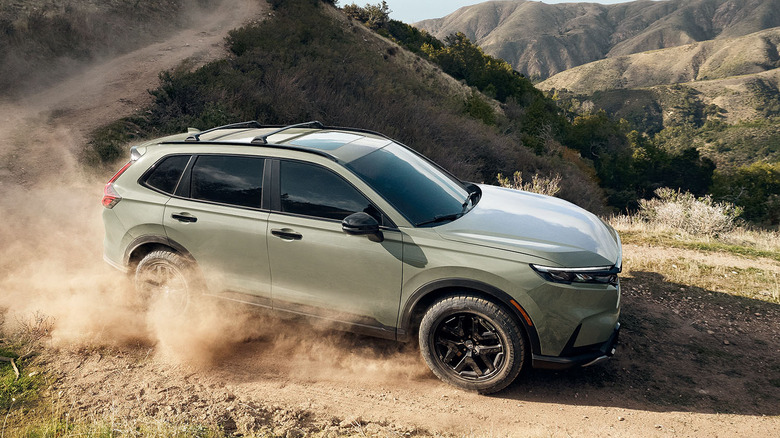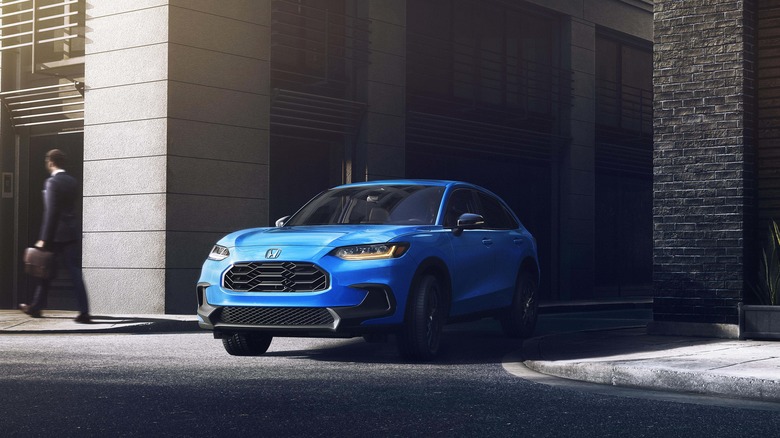Here's What CR-V Stands For On Your Honda And How It's Different From The HR-V
With crossovers and SUVs regularly dominating the sales charts, and now overtaking sedans in sales rankings, there's no understating just how important the CR-V is for Honda. While it used to be the Accord and Civic that were the perennial favorites at the top of Honda's sales charts, the CR-V has been Honda's best-selling model in America since 2017. In 2024 alone, Honda sold over 400,000 CR-Vs in America, outselling every other vehicle in the company's lineup by a huge margin.
SlashGear's own experience with Honda's sales champ made it easy to see why buyers like this crossover so much. We had good things to say about the latest Honda CR-V, especially in hybrid form, which delivers an excellent blend of fuel economy, comfort, refinement, and surprisingly good driving dynamics.
First emerging in the mid-1990s, the CR-V, or Comfort Runabout Vehicle was essentially a taller, higher-riding Honda Civic that could be had with an available all-wheel-drive system. Though the CR-V has evolved a lot in the 30 years since it debuted, it still uses that same basic formula today. Let's dig in a little further to see how the CR-V name originated, and also how the CR-V compares to Honda's similarly named HR-V.
Comfortable Runabout Vehicle
In a lot of ways, the roots of the CR-V can be traced back to the 4x4 Honda Civic Wagons of the late 1980s. Occupying a spot on our list of weirdest Hondas ever designed, the Civic 4x4 was very much ahead of its time, blending the driving dynamics and fuel economy of a small car with the increased interior cargo space, and a degree of off-road capability you typically only got in a larger truck or SUV.
The CR-V, which debuted globally in 1995, first arrived in America for the 1997 model year, and it was the next evolution of this formula. With the aptly-named Comfortable Runabout Vehicle, Honda retained the Civic's mechanical underpinnings, but added a more traditional SUV body, larger cargo area, and increased the ground clearance. Along with other new Japanese models from the mid-1990s like the Subaru Forester and Toyota RAV4, the CR-V represented a new type of vehicle. One that split the difference between a unibody passenger car and a dedicated body-on-frame SUV.
Needless to say, this crossover, or CUV form factor would become very popular very quickly, to the point where these days CUVs typically outsell their sedan or hatchback counterparts by a wide margin, and in many car company lineups, have replaced them altogether.
CR-V vs HR-V
With the segment being so popular today, the CR-V isn't the only small crossover that Honda offers. It's joined in the lineup by the Honda HR-V, which stands for Hi-rider Revolutionary Vehicle. The HR-V first debuted in America for the 2016 model year, and is essentially a smaller, less expensive take on the CR-V formula. At the moment, both the CR-V and the HR-V are based on the same platform that also underpins the Civic.
With the HR-V slotting below the CR-V in the lineup, it's a little smaller in every dimension, with the most dramatic difference coming in overall length, where the CR-V is five inches longer. As you'd expect, the HR-V is also less expensive than the CR-V. Though in the grand scheme of new car prices, the few-thousand-dollar difference between the two for most trim levels is not as big as you may think.
That relatively modest price increase for a larger vehicle is surely one of the reasons that CR-V sales were more than double what the HR-V sales were in 2024. Additionally, the CR-V is available with a more powerful, more fuel-efficient hybrid powertrain, while the HR-V is not. However, given Honda's push toward hybridization across its lineup, an HR-V Hybrid seems inevitable at this point. That could help shrink the sales gap between these two Honda crossovers.


